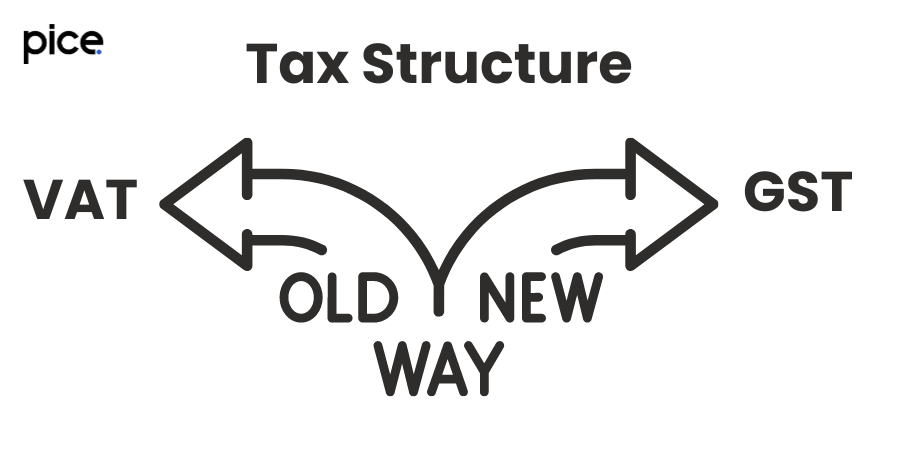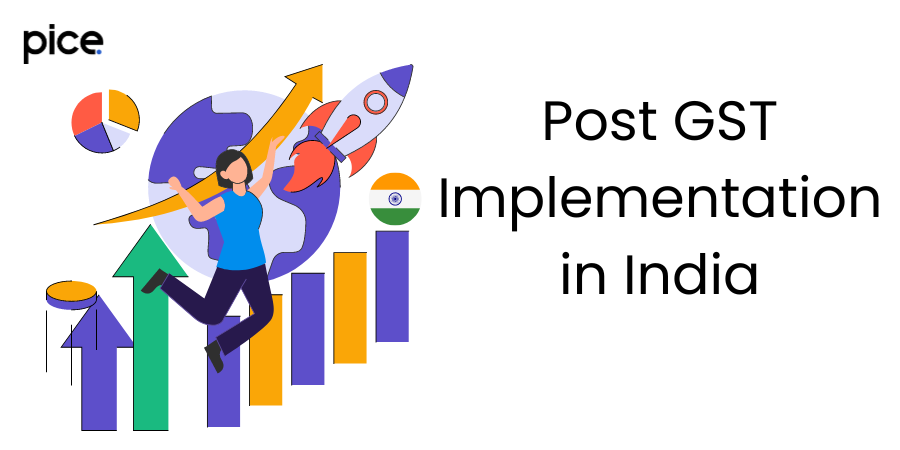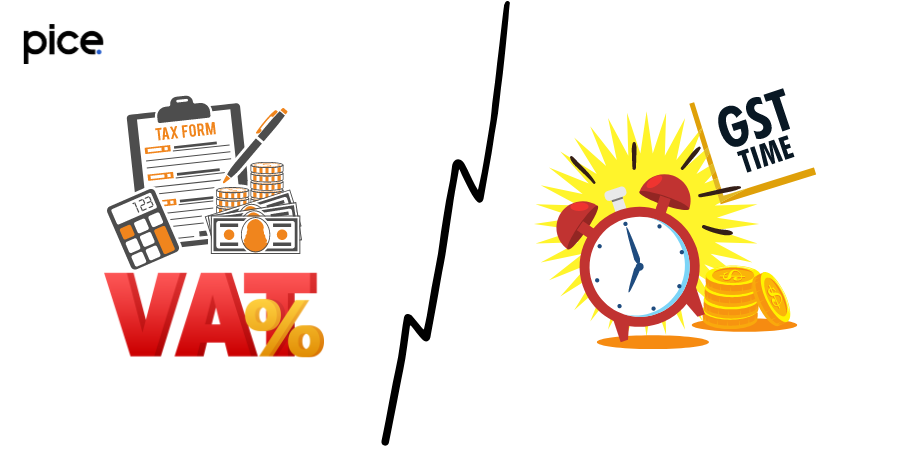Key Takeaways
- GST eliminates the cascading effect of taxes by allowing seamless input tax credits, reducing overall tax burdens.
- The introduction of GST simplifies India’s tax structure by replacing multiple indirect taxes with a unified system.
- GST enhances transparency and efficiency in tax compliance, benefiting both businesses and consumers.
- GST’s dual structure for central and state taxes ensures a consistent tax regime across India, promoting economic growth.
- The comprehensive compliance measures of GST, including electronic records and e-way bills, streamline the tax filing process and reduce evasion.
The implementation of the Goods and Services Tax (GST) marked a significant shift in India’s tax regime, replacing the old, complex system with a more streamlined and transparent structure.
Cascading Effect of Taxes
Under the old tax structure, the cascading effect of taxes, also known as “tax on tax,” was a significant issue. This phenomenon occurred when a tax was levied on a product at every stage of the production process without any mechanism to offset the taxes paid in previous stages. As a result, the final price of the product included multiple layers of taxes, leading to higher costs for consumers.
GST, as an indirect tax, addresses this issue by allowing for the Input Tax Credit (ITC). The ITC mechanism enables businesses to claim a credit for the taxes paid on inputs, which can be offset against the tax liability on the output. This reduces the overall tax burden and eliminates the cascading effect, leading to lower prices for consumer products and improving the efficiency of the supply chain. The seamless flow of credits across the entire supply chain ensures that tax compliance is maintained, and the benefits are passed on to the end consumers.
The introduction of GST has led to more uniform tax rates across the country, including union territories, which further reduces the disparities and inefficiencies caused by the old tax structure.
Comparison Between the Previous Tax System and GST

The previous tax system in India was a complex web of multiple indirect taxes levied by both the central and state governments. These included excise duty, service tax, VAT, and a host of other taxes, leading to a fragmented and inefficient tax regime. Each state had its own set of rules and tax rates, creating challenges for businesses operating across state lines and resulting in increased compliance burdens.
In contrast, GST has unified the entire nation under a single tax regime. It replaced various central and state taxes with a single tax applicable nationwide, thus simplifying the tax structure. This uniform tax system reduces the compliance burden on businesses, as they now need to adhere to a single set of tax laws instead of multiple regulations. Additionally, GST’s destination-based tax approach ensures that taxes are levied at the point of consumption, leading to a fair distribution of tax revenues among states.
By harmonizing tax rates and regulations, GST facilitates a more efficient supply chain and reduces the cost of compliance. The implementation of electronic records and e-way bills further streamlines the process, making it easier for businesses to file taxes and maintain compliance.
Reasons for Introducing GST
The introduction of GST was driven by the need to address the inefficiencies and complexities of the previous tax system. One of the primary reasons was to eliminate the cascading effect of taxes, which increased the cost of goods and services and hindered economic growth. By allowing for the input tax credit mechanism, GST reduces the tax burden on businesses and consumers alike.
GST also aimed to create a more transparent and efficient tax system. The old tax regime was characterized by multiple taxes and a lack of uniformity, leading to tax evasion and revenue loss. GST’s uniform tax rates and comprehensive compliance measures promote greater transparency and accountability.
💡 If you want to pay your GST with Credit Card, then download Pice Business Payment App. Pice is the one stop app for all paying all your business expenses.
Furthermore, GST was introduced to improve the ease of doing business in India. The previous system’s complexity and varying tax rates across states created hurdles for businesses, especially those involved in inter-state supplies. With GST, businesses benefit from a simpler tax regime, reduced compliance costs, and a more predictable tax environment, fostering economic growth and attracting investment.
Benefits of GST Over VAT
GST offers several benefits over the previous VAT system. Firstly, GST’s comprehensive input tax credit mechanism ensures that taxes paid on inputs can be claimed as credits, reducing the overall tax burden. This was not as effectively managed under VAT, leading to the cascading effect.
Secondly, GST’s uniform tax rates across the country simplify the tax structure and reduce discrepancies between states. Under VAT, different states had different tax rates, creating challenges for businesses operating in multiple states.
Lastly, GST’s focus on electronic records and compliance measures enhances transparency and reduces the scope for tax evasion. The VAT system lacked such robust mechanisms, making it easier for businesses to evade taxes.
Components of GST
GST is composed of several key components that together create a unified and efficient tax system. These components include Central GST (CGST), State GST (SGST), Integrated GST (IGST), and Union Territory GST (UTGST). Each component plays a specific role in the tax structure.
CGST and SGST are levied on intra-state supplies of goods and services. While CGST is collected by the central government, SGST is collected by the respective state governments. IGST is levied on inter-state supplies and is collected by the central government, which then distributes it between the central and state governments. UTGST is similar to SGST but is applicable in union territories.
These components ensure a seamless flow of tax credits across the entire supply chain, reducing tax burdens and promoting compliance. The implementation of electronic records, e-way bills, and online payment systems further streamlines the tax filing process and enhances transparency.
GST vs Old Tax
The key differences between GST and VAT lie in their structure and implementation. GST is a comprehensive tax system that subsumes various indirect taxes, while VAT was primarily focused on the sale of goods.
Under VAT, different states had the authority to levy their own tax rates, leading to inconsistencies and higher compliance burdens for businesses. GST, with its uniform tax rates and central oversight, eliminates these discrepancies and simplifies the tax structure.
Another significant difference is the input tax credit mechanism. GST allows for a seamless flow of credits across the supply chain, reducing the overall tax burden. VAT had a more limited scope for input tax credits, leading to the cascading effect of taxes.
Input Tax Credit Mechanism
The input tax credit (ITC) mechanism is one of the most significant features of GST. It allows businesses to claim a credit for the taxes paid on inputs, which can be offset against the tax liability on the output. This mechanism ensures that taxes are levied only on the value added at each stage of production, eliminating the cascading effect of taxes.
Under the old tax structure, businesses often faced the burden of multiple taxes without any mechanism to claim credits, leading to higher costs. GST’s ITC mechanism reduces this burden, promotes tax compliance, and ensures that the benefits of reduced taxes are passed on to consumers.
The ITC mechanism also improves the efficiency of the supply chain, as businesses can claim credits for taxes paid on goods and services used in production. This leads to lower costs, increased competitiveness, and better pricing for consumer products.
Transparency in Taxation
GST has significantly improved transparency in taxation. The old tax regime was characterized by multiple taxes and a lack of uniformity, making it easier for businesses to evade taxes. GST’s uniform tax rates and comprehensive compliance measures promote greater transparency and accountability.
The implementation of electronic records and e-way bills ensures that all transactions are documented and tracked, reducing the scope for tax evasion. The online payment system and ERP E-TDS return filing solution further streamline the process, making it easier for businesses to file taxes and maintain compliance.
This increased transparency benefits both the government and businesses. The government can more effectively track tax revenues and reduce evasion, while businesses benefit from a more predictable and stable tax environment.
Differences Between VAT and GST in Various Tax Contexts
The differences between VAT and GST are evident in various tax contexts, including the treatment of inter-state supplies, the calculation of tax, and the compliance requirements.
Under VAT, inter-state supplies were subject to Central Sales Tax (CST), leading to higher tax burdens and compliance challenges. GST, with its integrated IGST component, simplifies the taxation of inter-state supplies and reduces the compliance burden on businesses.
The calculation of tax under GST is more straightforward and transparent compared to VAT. GST’s input tax credit mechanism ensures that taxes are levied only on the value added at each stage, while VAT’s limited scope for credits led to the cascading effect of taxes.
GST’s comprehensive compliance measures, including electronic records, e-way bills, and online payment systems, enhance transparency and reduce the scope for tax evasion. VAT lacked such robust mechanisms, making it easier for businesses to evade taxes and increasing the compliance burden.
Calculation of Tax Under GST and VAT
The calculation of tax under GST is more straightforward and transparent compared to VAT. GST is a comprehensive tax system that subsumes various indirect taxes, while VAT was primarily focused on the sale of goods.
Under GST, taxes are levied on the value added at each stage of production, and businesses can claim input tax credits for taxes paid on inputs. This ensures that the final tax is levied only on the value added, eliminating the cascading effect of taxes.
In contrast, VAT had a more limited scope for input tax credits, leading to the cascading effect of taxes. The final price of goods under VAT included multiple layers of taxes, increasing the cost for consumers.
GST’s uniform tax rates and comprehensive compliance measures further simplify the tax calculation process, making it easier for businesses to file taxes and maintain compliance.
India Before and After GST Implementation

The implementation of GST has had a profound impact on India’s economy and tax system. Before GST, the tax structure was characterized by multiple indirect taxes, varying tax rates across states, and a lack of uniformity, leading to inefficiencies and higher compliance burdens.
After GST, the entire nation is unified under a single tax regime, simplifying the tax structure and reducing the compliance burden on businesses. The introduction of electronic records, e-way bills, and online payment systems enhances transparency and reduces the scope for tax evasion.
Economic Impact
The economic impact of GST has been significant. The elimination of the cascading effect of taxes and the reduction of tax burdens on businesses and consumers have led to lower prices for goods and services. This, in turn, has increased consumption and boosted economic growth.
GST’s uniform tax rates and comprehensive compliance measures promote a more predictable and stable tax environment, attracting investment and fostering economic growth. The improved efficiency of the supply chain and reduced compliance costs further enhance the competitiveness of Indian businesses in the global market.
The increased transparency and accountability in taxation also benefit the government by improving tax revenues and reducing evasion, contributing to overall economic stability.
Impact on Consumers
The impact of GST on consumers has been largely positive. The elimination of the cascading effect of taxes and the reduction of tax burdens have led to lower prices for consumer products. This increase in affordability has boosted consumption and improved the standard of living for many Indians.
GST’s uniform tax rates and comprehensive compliance measures ensure that the benefits of reduced taxes are passed on to consumers. The increased transparency and accountability in taxation also protect consumers from price manipulation and ensure fair pricing.
The introduction of electronic records and e-way bills further enhances transparency and reduces the scope for tax evasion, benefiting consumers by ensuring that taxes are properly accounted for and reducing the likelihood of price inflation due to tax evasion.
Implications for Businesses
The implications of GST for businesses have been profound. The simplification of the tax structure and the reduction of compliance burdens have made it easier for businesses to operate and expand. The elimination of the cascading effect of taxes and the input tax credit mechanism reduce costs and improve competitiveness.
GST’s uniform tax rates and comprehensive compliance measures create a more predictable and stable tax environment, fostering investment and economic growth. The implementation of electronic records, e-way bills, and online payment systems further streamline the process, making it easier for businesses to file taxes and maintain compliance.
Overall, the introduction of GST has created a more efficient, transparent, and business-friendly Indian taxation environment, benefiting businesses and consumers alike.
FAQs
Why was GST Introduced?
GST was introduced to replace the old, fragmented tax system with a more streamlined consumption tax that eliminates tax cascading and broadens the tax base. It simplifies tax compliance by creating a dual structure for both central and state taxes, thereby improving direct tax compliance and overall efficiency in tax payments.
What are its Benefits Over VAT?
GST offers several benefits over VAT, including the elimination of tax cascading, which reduces overall tax burdens. It also provides a more comprehensive tax base and enhances transparency in filing taxes, leading to more accurate reporting of taxable income and better financial decisions for businesses.
What are the Differences Between GST and VAT?
The primary differences between GST and VAT lie in their structure and implementation. GST employs a dual structure for central and state taxes, reducing tax cascading and simplifying tax payments. In contrast, VAT was state-specific and often led to inefficiencies and higher compliance burdens.
How Is GST Different From The Old Tax System We Had Before?
GST differs from the old tax system by unifying various indirect taxes into a single consumption tax, thereby eliminating the cascading effect. It simplifies the process of filing taxes and enhances direct tax compliance through a more transparent and comprehensive tax base.
How does GST work?
GST operates on a dual structure where both the central and state governments levy taxes on the supply of goods and services. Businesses file GST returns to report their taxable income and claim input tax credits, which helps avoid tax cascading and ensures a smoother process for tax payments.
What are the benefits of GST?
The benefits of GST include reducing the cascading effect of taxes, broadening the tax base, and simplifying tax compliance. It facilitates better financial decisions for businesses through accurate reporting of annual income and enhances overall efficiency in tax filing and payments.
What are the GST rates?
GST rates in India are categorized into multiple slabs to accommodate different types of goods and services. The primary rates are 0%, 5%, 12%, 18%, and 28%, with certain items like luxury goods and sin products attracting higher rates. These rates ensure a broad tax base while maintaining fairness and efficiency in tax payments across various sectors.








